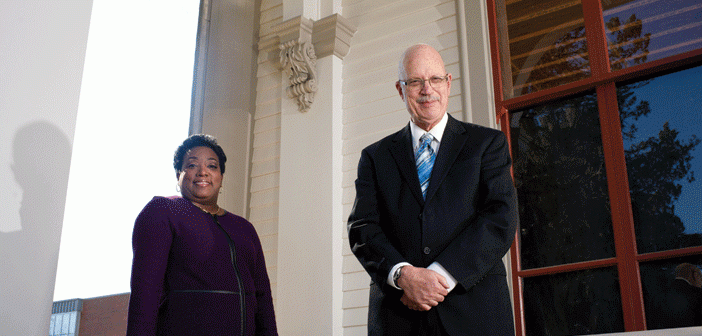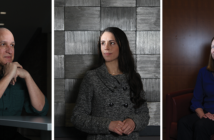Today, underrepresented minorities in medicine—black, Hispanic, or Native American—make up 24 percent of the Alpert medical student body, compared to 17.6 percent of med students nationwide, and 13.5 percent of practicing physicians. Yet only 63 percent of the US population identifies as white—meaning a significant number of Americans may not find a doctor who looks like them. “Some people still don’t trust white physicians,” says Tougaloo Professor Wendy White, PhD, MPH. Referring to the infamous federal syphilis experiment, she adds, “They all remember Tuskegee.”
Cultural Divide
In the mid-20th-century South, “the saddle you have to wear of continuing discrimination, you think, I don’t want to raise my kids here,” says Adams, an Arkansas native who earned his bachelor’s degree at Boston University and his master’s at Harvard. Aspiring physicians at Tougaloo had few opportunities close to home: the University of Mississippi Medical Center is just a few miles south of the Tougaloo campus, yet its affiliation with Ole Miss, where segregationists rioted to block an African American student’s enrollment in 1962, deterred black applicants.
Civil rights activists were streaming into the South, including one Harvard doctoral student who wanted to see more African Americans in the sciences. Richard McGinnis began tutoring black students in the summer of 1965 and, upon earning his PhD, joined the chemistry department at Tougaloo and worked with pre-med students. When Brown established the Program in Medicine a few years later, the University chaplain, the Rev. Charles A. Baldwin II, who had championed the Tougaloo partnership, encouraged Aronson to meet with McGinnis to discuss a medical exchange program. (All three men were honored—Baldwin posthumously—at the Brown- Tougaloo Partnership anniversary celebration last November.) In the summer of 1975, three Tougaloo pre-meds arrived in Providence to complete research fellowships; building on that success, Brown committed to the EIP.
Initially, the exchange program was just that: as Tougaloo students traveled North to study, some medical students went South to complete clinical rotations in Jackson, often with Robert Smith, MD, a Tougaloo alum who mentored students at his alma mater and was a visiting professor at the Medical School. Over the years, however, the elective clerkship has fallen by the wayside; few opt to do it anymore. Adams suspects students fear the “cultural adjustment to Mississippi.” Indeed, Tougaloo alums are still challenging misconceptions about the South. “I would hear from classmates, oh my goodness, Galen, you scored higher than me, and you went to Tougaloo, not Brown undergrad!” Henderson recalls. Courtney Johnson PhD’15 MD’17 adds, “There’s a perception of the South that we’re walking around barefoot.” But Johnson likes being able to offer a different perspective; and, she says, “when I would see something that’s not culturally sensitive, I could speak up to the administration” and work to correct it.
That’s not to say Tougaloo students never struggle. “You get used to being a big fish in a small pond,” says White. She is the assistant director of the college’s Jackson Heart Study Program, which collaborates with the National Institutes of Health to train pre-meds in cardiovascular research. Tougaloo students apply through a rigorous process as freshmen; for many, it’s the first step toward admission to the EIP. “A lot of students are so successful in high school and college they don’t know how to fail,” White says. “I’ll give them a pep talk: medical school is not like anything you’ve ever done.”
McGinnis, who still teaches chemistry and is dean of Tougaloo’s Division of Natural Sciences, admits that majors from his department can have trouble with the biology-heavy curriculum of medical school. Each year he does his best to ensure that the five or six applicants to the EIP are up to the challenge, seeing that they shadow health professionals in the Jackson area, take advantage of research and other educational opportunities, meet prerequisites, and keep their grades up. “Though he’s not African American,” Adams says of McGinnis, “he’s as dedicated to the education and nurturing of African American students as anyone I’ve ever met.”
Jabbar R. Bennett, PhD, associate dean for diversity and director of the Office of Diversity and Multicultural Affairs at Alpert Medical School, and Zoila Quezada, MEd, the office’s assistant director, travel to Jackson each year to interview Tougaloo sophomores for the EIP and to visit older students already in the pipeline. (Quezada and Bennett recommend students to Medical School admissions officers, who make the ultimate decision; Bennett also serves on the admissions committee.) As a condition of their admission to the Medical School, Tougaloo students spend one undergrad semester at Brown, to get a taste of Ivy League, and New England, life. “The exchange gives them a sense of what it’s like up there,” McGinnis says. “Some decide not to go after the semester at Brown.”
But Quezada says that happens rarely; the competitive program is the reason many students apply to Tougaloo in the first place. Indeed, Henderson says adjusting to life at a school with such a storied civil rights history was the greater struggle. “Even though it’s a tiny, tiny little campus, [Tougaloo] was a big place in my mind,” he says.
When Tougaloo graduates arrive in Providence, it’s hardly sink or swim; they have a built-in alumni network to help them adjust to everyday life as well as the rigors of medical school. “It was tough being away from my family, but they were replaced by my [Tougaloo] big brothers and big sisters,” says Montoya Taylor MD’08, a cardiology fellow at The Ohio State University. He quickly felt at home at the Medical School, he adds. “They really nurture you,” Taylor says. “Brown is like Tougaloo—the small classes, the close-knit community.”
White, who stays in close contact with her former students, calls Brown “one of the most Southern places up there. People are so friendly.” She adds: “We’ve had students go to several different medical schools, but the support system pales in comparison to what they get at Brown. Brown goes above and beyond.”



